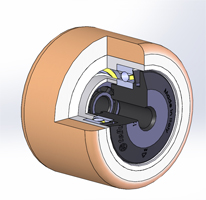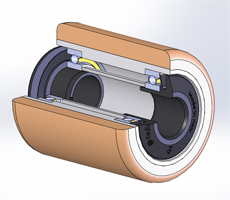
Specifically designed for::
• assembly on electric pallet trucks, both walk-behind model and with operator on board
• ensuring a longer product life under continuous mechanical handling

Technical features
The safety and ease of handling of a trolley depend on the choice of the most suitable wheel.
The choice must be made in accordance with the following procedure:
For each series, Iberruedas indicates the type of floor for which the wheel is suitable.
Iberruedas provides:
- a table showing compatibility of the wheel materials with a detailed list of chemical substances (see table --> open pdf file).
- a table showing derating of carrying capacity in accordance with different temperatures (see table --> open pdf file).
With a 4-wheel trolley, use the following formulas to calculate the minimum carrying capacity required
:
Solid load:
| MINIMUM CARRYING CAPACITY REQUIRED = (SOLID LOAD WEIGHT + TROLLEY TARE): 3 (3 out of 4 wheels are considered to be constantly in contact with the ground). |
Liquid load:
| MINIMUM CARRYING CAPACITY REQUIRED = (LIQUID LOAD WEIGHT + TROLLEY TARE): 2 (2 out of 4 wheels are considered to be alternately in contact with the ground). |
Iberruedas specifies the static and dynamic carrying capacity values and the rolling resistance for each wheel.
Static use
For static use (trolley moved only occasionally and stationary most of the time) it is sufficient to check:
| STATIC CARRYING CAPACITY OF THE WHEEL > MINIMUM CARRYING CAPACITY REQUIRED (3 out of 4 wheels are considered to be constantly in contact with the ground). |
Conversely, if the trolley is to be used frequently or over long distances, the type of handling must be assessed: manual, towed with mechanical means or self-powered.
Manual handling
The trolley speed is generally less than 4 km/h; check that:
| DYNAMIC CARRYING CAPACITY OF THE WHEEL > MINIMUM CARRYING CAPACITY REQUIRED ROLLING RESISTANCE > (SOLID/ LIQUID LOAD WEIGHT + TROLLEY TARE): 4 |
The lower the rolling resistance of a wheel, the less effort is required.
Iberruedas shows the rolling resistance value for each wheel, this being the maximum applicable load at which the traction/thrust effort remains below 5 daN.
Towed mechanical propulsion
The dynamic carrying capacity of the wheels refers to a speed no higher than 4 km/h (1.1 m/s); if the speed exceeds this value, the carrying capacity value decreases. Use the carrying capacity correction factor shown in the speed and capacity variations table (see table --> open pdf file) and check:
| WHEEL DYNAMIC CARRYING CAPACITY X CORRECTION FACTOR (%) > MINIMUM REQUIRED CARRYING CAPACITY |
Not all the types of wheel can be used with mechanical propulsion; choose only the series shown in the table, combined with adequate castors.
Self-powered mechanical propulsion
In this case the wheels are subjected to particular types of stress that differ from case to case. Contact Iberruedas to choose the most suitable product for your application.
Iberruedas SPA - Società Unipersonale - Via Quattro Passi 15, 41043 Formigine (MO) - Italy - P.IVA/VAT NUMBER IT00180900367 - Capitale Sociale € 3.640.000 i.v - R.E.A. MO nr. 65528 – Reg. Imprese MO nr. 00180900367 Italia: 059 410300-306, E-mail: comm.italia@tellurerota.com - Estero: +39 059 410302, E-mail: comm.estero@tellurerota.com - Fax: +39 059 572859